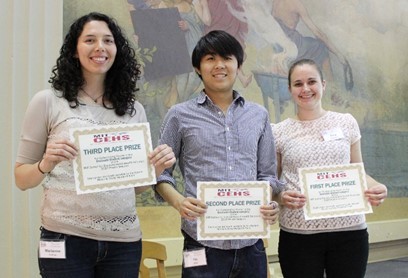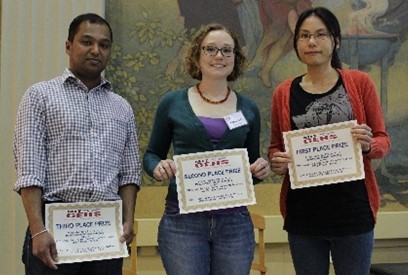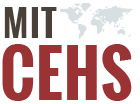The Center for Environmental Health Sciences (CEHS) at MIT held its annual poster session on May 13, 2015 at the Morss Hall, Walker Memorial Building (50-140). The session highlighted the work of the environmental health research communities of MIT and some of our sister institutions. Over sixty posters were presented from the science and engineering laboratories affiliated with the Center. We would like to thank all of the poster presenters for participating in this event.
This event was also featured in the MIT News.
The CEHS has an overall mission to study the biological effects of exposure to environmental agents in order to understand, and predict, how such exposures affect human health. Moreover, by uncovering the chemical, biochemical and genetic bases for environmental disease, sometimes we are able to leverage that understanding to delay or even prevent the development of disease in human populations. To that end, the Center brings together 39 MIT faculty members from a total of nine MIT departments (in both the School of Science and the School of Engineering) plus one Harvard faculty member from the Harvard School of Public Health (HSPH).
This year’s CEHS cash prizes are awarded in two categories, graduate students and postdoctoral scholars. For each category, the prize for first-place is $1,000, second-place prize is $500, and the third-place prize is $200 plus CEHS memorabilia. The cash prizes were made possible by the Myriam Marcelle Znaty Research Fund, which was established nearly 30 years ago to support the research of young scientists at MIT.
Graduate Students, Postdoctoral Scholars, and Research staff presented the results of their research at MIT's Morss Hall. The CEHS 2015 Poster Winners are mentioned below.
Ms. Amy Rabideau from Professor Bradley Pentelute’s lab won first place in the graduate student category. Amy presented her work on the “delivery of polypeptides and antibody mimics into cells using anthrax toxin.” In second place is Mr. Fei Chen, from Professor Edward Boyden’s lab, who presented his work on “expansion microscopy.” Finally, in third place is Ms. Marianna Sofman, from Professor Linda Griffith’s lab, who presented her work on “engineering angiogenesis: a materials approach to vascularizing tissue.”
In the postdoctoral scholar category, first place went to Dr. Kelly W.L. Chen, from Professor Douglas Lauffenburger’s lab, who presented her work on “multivariate analysis of intestinal epithelial cell and immune cell crosstalk in normal and inflammatory conditions.” Second place went to Dr. Kathryn B. Smith-Dupont, from Professor Katharina Ribbeck’s lab, who presented her work on “biophysical tools for understanding the barrier properties of mucus: cervical mucus as a case study.” And lastly, Dr. Uthpala Seneviratne, from Professor Steven Tannenbaum’s lab, took third place after presenting his work on “decoding the S-nitroso proteome in a mouse model of Alzheimer’s by SNOTRAP and mass spectrometry–clues for altered signaling pathways.”
Pictures of the winners:
Graduate student winners (from left to right): Marianna Sofman (3rd place), Fei Chen (2nd place), and Amy Rabideau (1st place).

Postdoctoral Scholar winners (from left to right): Uthpala Seneviratne (3rd place), Kathryn B. Smith-Dupont (2nd place), and Kelly W.L. Chen (1st place).


